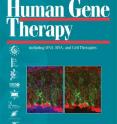Advances in delivery of therapeutic genes to treat brain tumors
Novel tools and methods for delivering therapeutic genes to cells in the central nervous system hold great promise for the development of new treatments to combat incurable neurologic diseases. Five of the most exciting developments in this rapidly advancing field are presented in a series of articles in the June issue of Human Gene Therapy, a peer-reviewed journal published by Mary Ann Liebert, Inc. (www.liebertpub.com). The articles are available free online at www.liebertpub.com/hum A review article by Betley and Sternson, "Adeno-Associated Viral Vectors for Mapping, Monitoring, and Manipulating Neural Circuits," highlights the latest genetic tools that are enabling cell type-specific delivery of transgenes for studying the structure and function of neuronal circuits.
Ryu et al. report on the successful use of stem cells derived from human umbilical cord blood to deliver a novel therapeutic gene—interleukin-12—to the brain for long-term anti-tumor activity against gliomas, a deadly type of brain tumor. Their innovative strategy is presented in the research report "Gene Therapy of Intracranial Glioma Using Interleukin 12-Secreting Human Umbilical Cord Blood-Derived Mesenchymal Stem Cells."
"High-Density Lipoprotein Facilitates In Vivo Delivery of α-Tocopherol-Conjugated Short-Interfering RNA to the Brain" by Uno et al. describes a combination strategy for dramatically improved delivery of siRNAs to the brain to silence genes involved in neurological disease.
Loss of the neurotrophic factor GDNF contributes to the development of neuropathic pain caused by trauma or neurodegenerative disease. Shi et al. present data to support this link and demonstrate the potential to replace GDNF via intramuscular gene delivery in the article "Glial Cell Line-Derived Neurotrophic Factor Gene Transfer Exerts Protective Effect on Axons in Sciatic Nerve Following Constriction-Induced Peripheral Nerve Injury."
The use of adenoviral vectors as carriers of therapeutic genes to the cerebrospinal fluid has the potential to enable long-term gene expression for the treatment of neurological diseases. In the brief report "Intrathecal Injection of Helper-Dependent Adenoviral Vectors Results in Long-Term Transgene Expression in Neuroependymal Cells and Neurons" Dindot et al. describe the successful use of adenoviral vectors to transduce neuronal cells.
"Treating neurologic diseases with traditional biologic products such as therapeutic proteins has been challenging due to limited access. The use of vectors helps to overcome these barriers," says James M. Wilson, MD, PhD, Editor-in-Chief, and Director of the Gene Therapy Program, Department of Pathology and Laboratory Medicine, Perelman School of Medicine, University of Pennsylvania, Philadelphia.
Source: Mary Ann Liebert, Inc./Genetic Engineering News
Other sources
- Advances in delivery of therapeutic genes to treat brain tumorsfrom PhysorgMon, 27 Jun 2011, 20:00:39 UTC
- Advances in delivery of therapeutic genes to treat brain tumorsfrom Science DailyMon, 27 Jun 2011, 19:30:32 UTC
- The promise of stem cell-based gene therapyfrom PhysorgMon, 27 Jun 2011, 17:01:53 UTC
